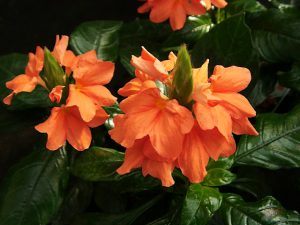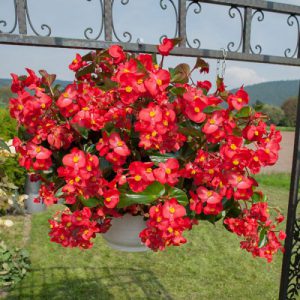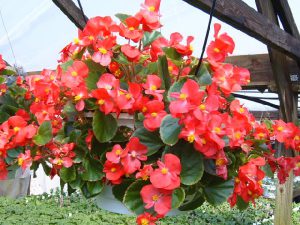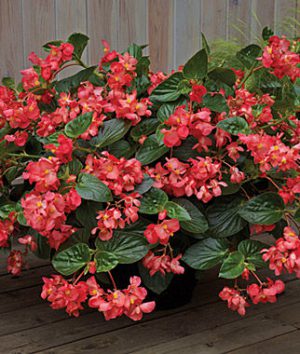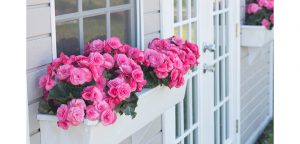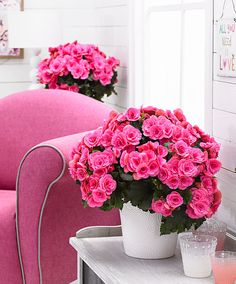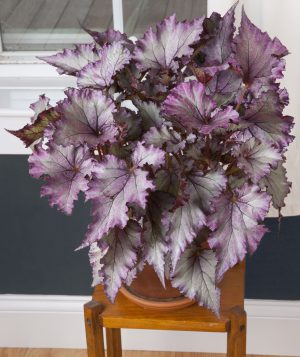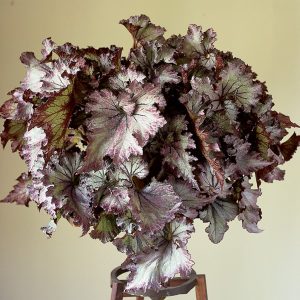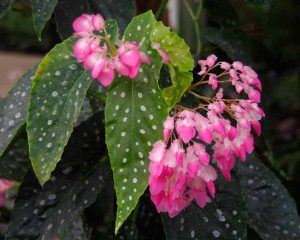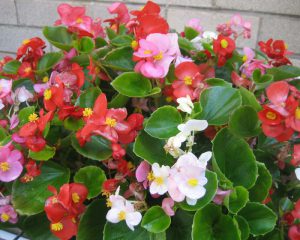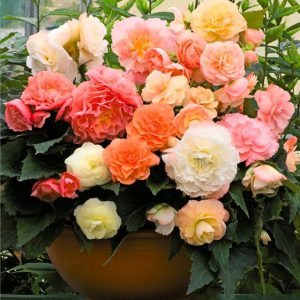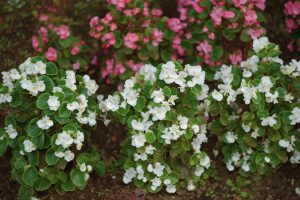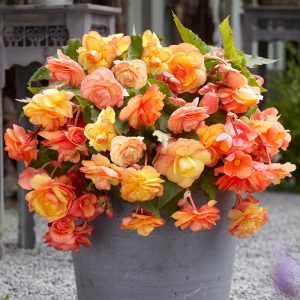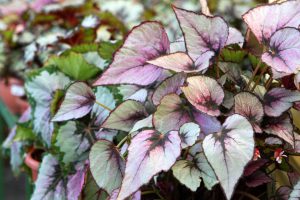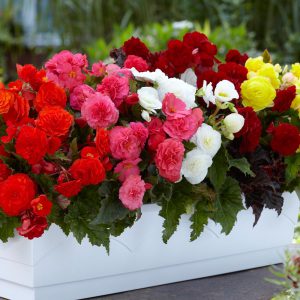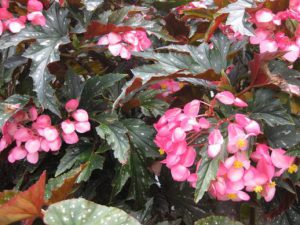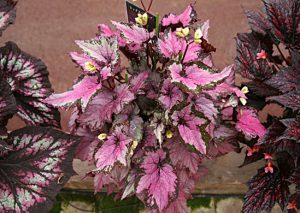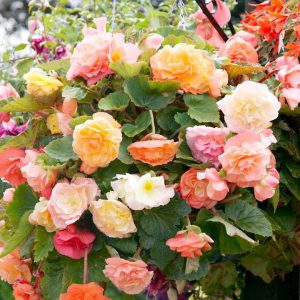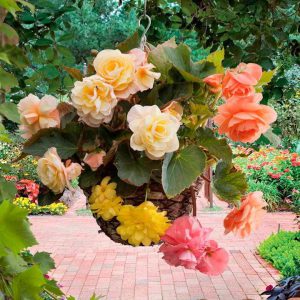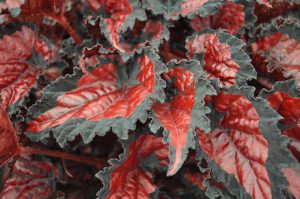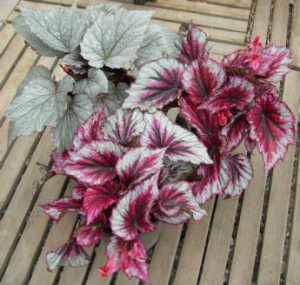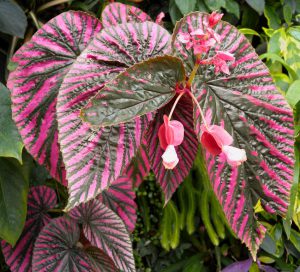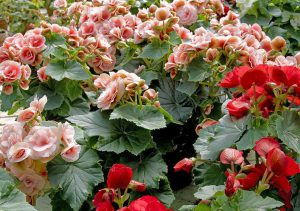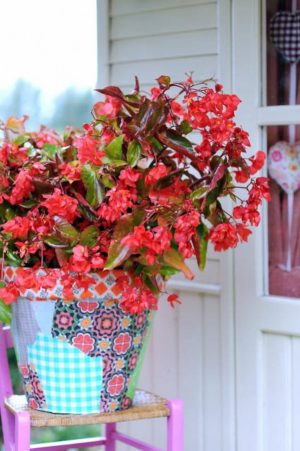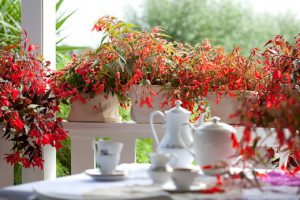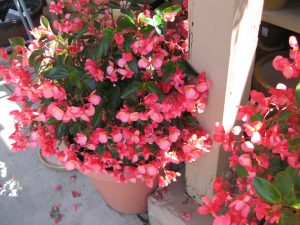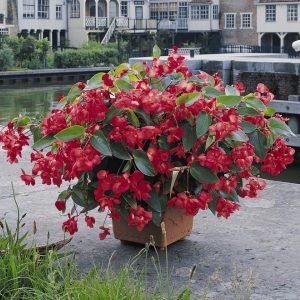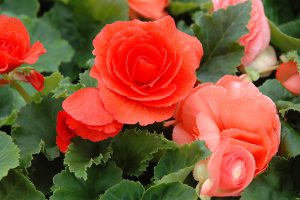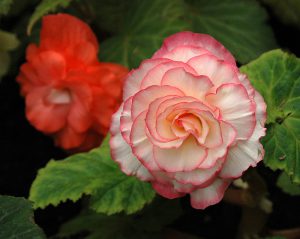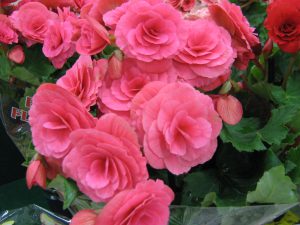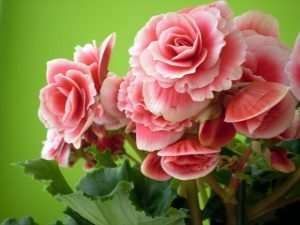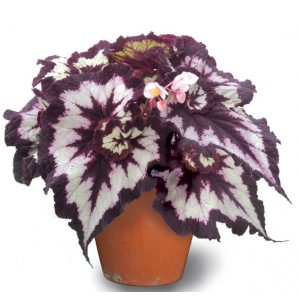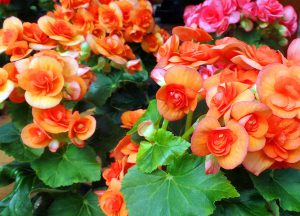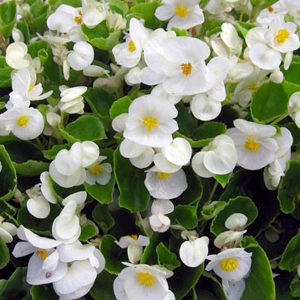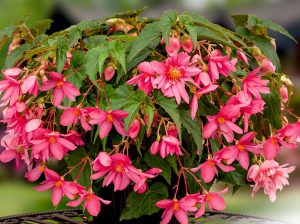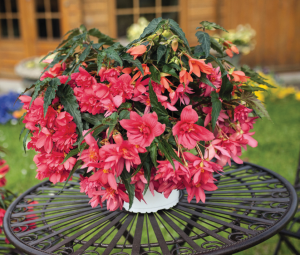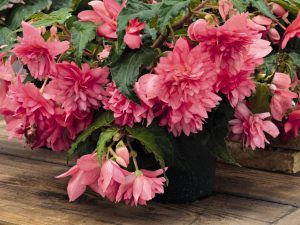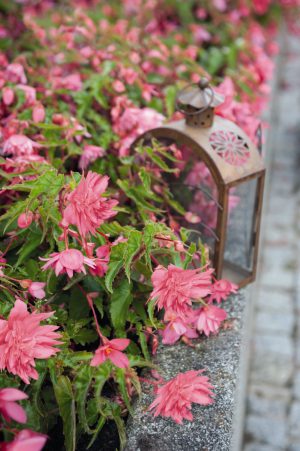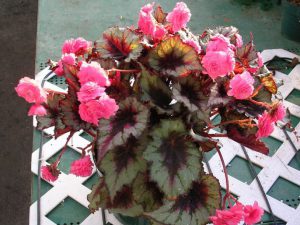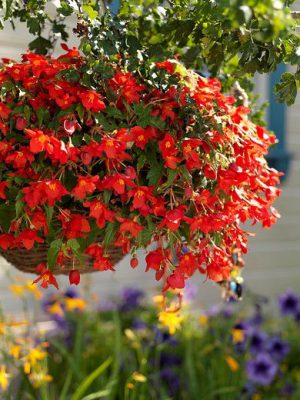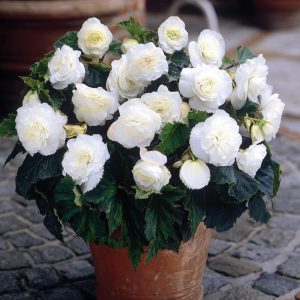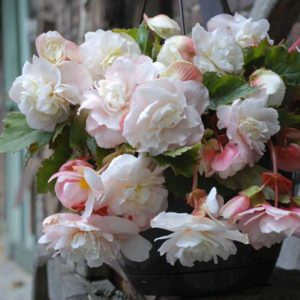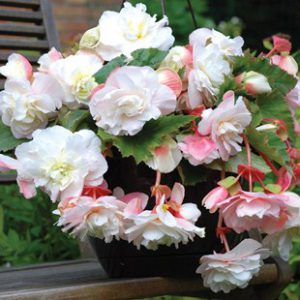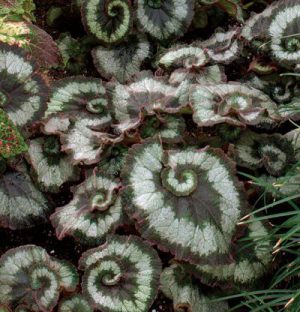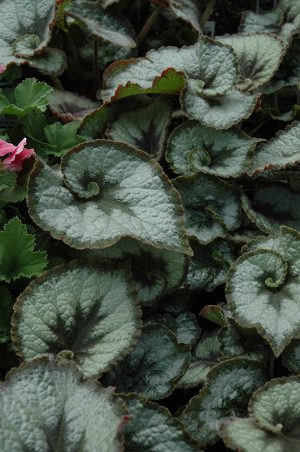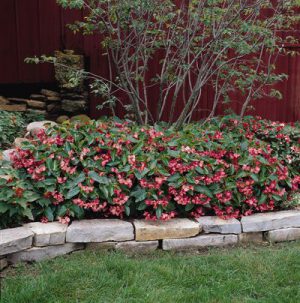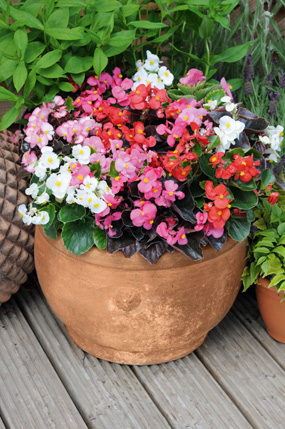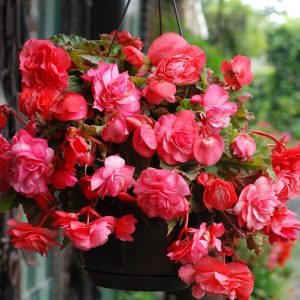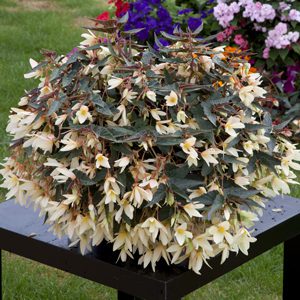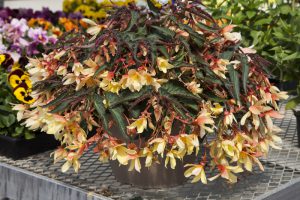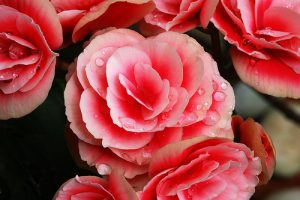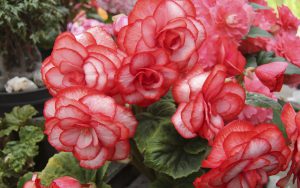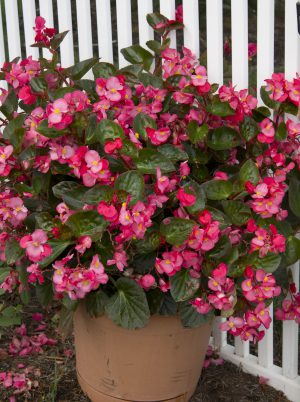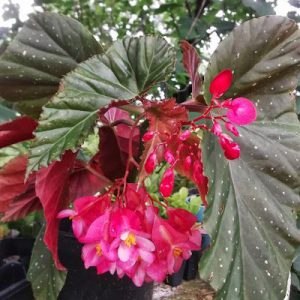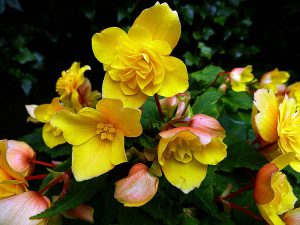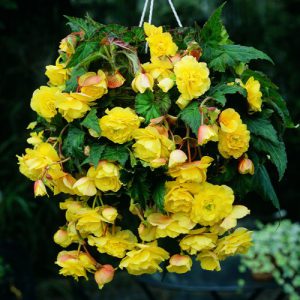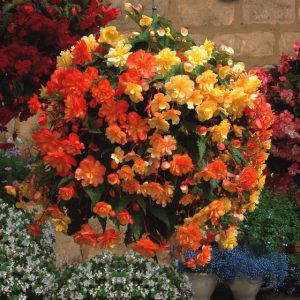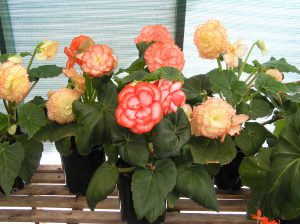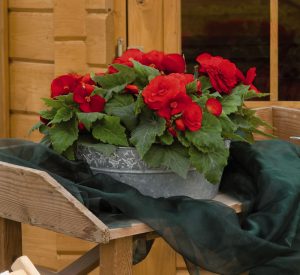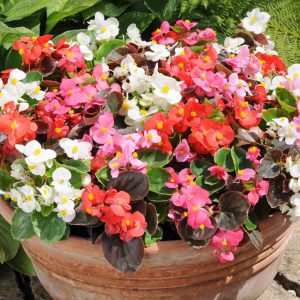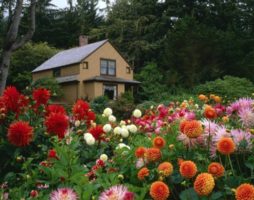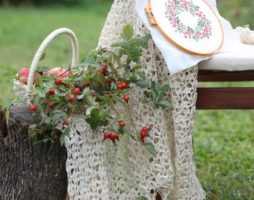Begonia is a lush and brightly flowering plant with decorative asymmetrical leaves, which is considered to be the birthplace of tropical forests and subtropical zones of Africa, America and Asia.
Most popular types
There are almost 900 varieties of this perennial, about 2,000 hybrids have been bred.
Indoor crops can be divided into 2 types: flowering and deciduous. A characteristic feature of the latter is the unusual shape and color of the leaves. Flowering ones are divided into subgroups: bushy, tuberous, evergreen.
The most popular are the following types:
- Everblooming. This kind of bushy begonia can exist both in the garden and at home. When kept at home, it may not stop flowering year-round. Signs: reddish or green-colored leaves, small white, red or pink flowers.
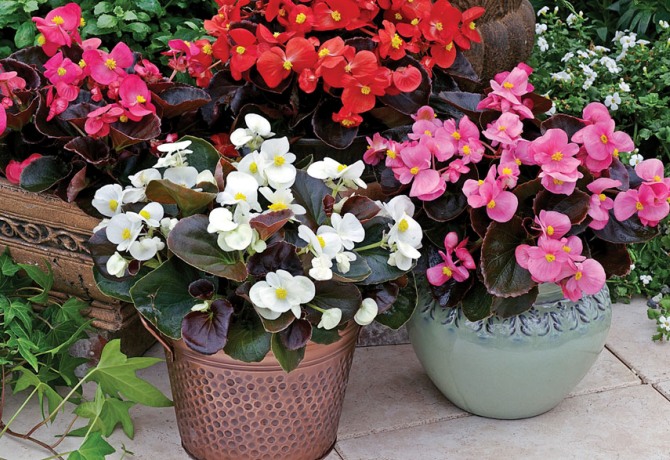
ever blooming begonia
- Tuberous. A plant with double yellow, orange, white, juicy red or pink flowers of a simple form. Petals - with a border or two-color. The flowers are large, can reach 15 cm, the shape is similar to peony, rose and carnation.
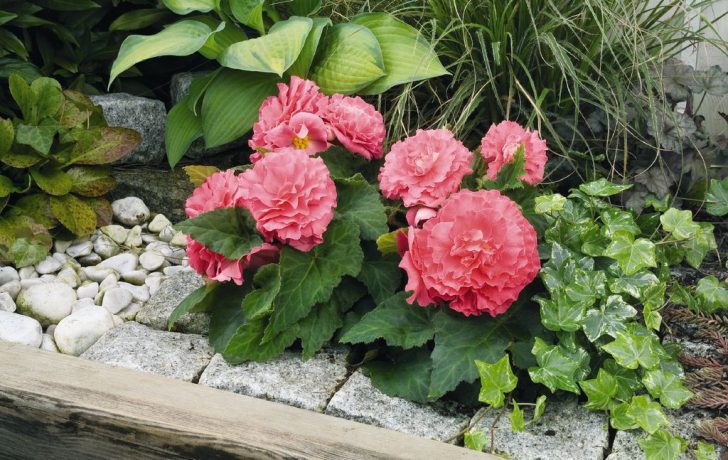
tuberous begonia
- Royal. This variety of begonia, belonging to the group of decorative foliage, grows up to 30 cm. It has leaves painted in dark green, red or brown. The shape of the leaves is heart-shaped or spiral.
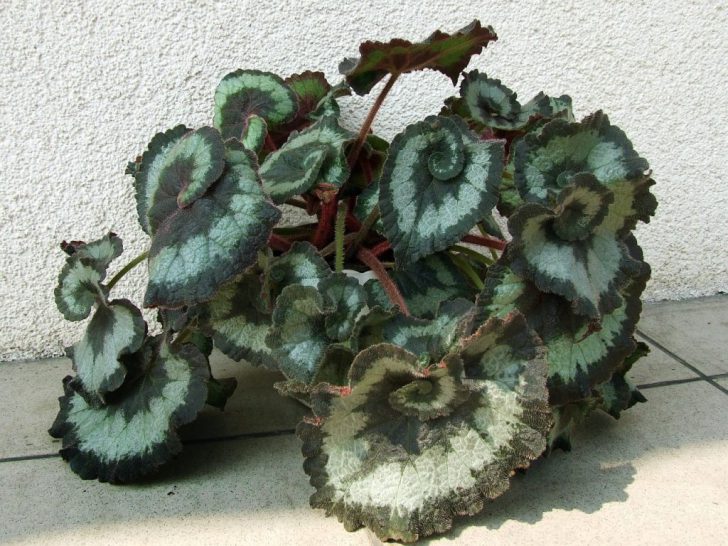
Royal begonia with spiral leaves
- Elator. A tuberous hybrid is only suitable for growing at home. The shoots of the plant are thin, red. Flowers reach 5 cm in diameter. Petals can be red, white, orange or yellow. Leaves are round and glossy. The flowering period is in autumn and winter.
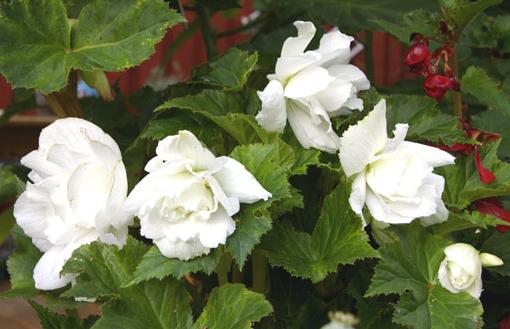
Begonia Elatior for growing at home
- Ampelnaya. Also applies to tubers. Designed for vertical gardening: shoots hang down by 25 - 50 cm, they are orange, crimson, white or yellow flowers that continue to bloom throughout the growing season.

Ampel begonia
Rules for caring for room begonia
"Due to the tropical origin, the level of air humidity is important for room begonia"
A plant for growing indoors is undemanding and requires almost no care. Grows well in moderate temperatures. It doesn't need to be repotted often. The only thing is that because of its tropical origin, the level of air humidity is important to it. Some types of room begonia require a dormant period after the flowering period.
Proper lighting and watering regime
For keeping begonias, a room with good lighting is optimal. For varieties that bloom profusely, diffused light is desirable, while moderate lighting is suitable for decorative foliage.
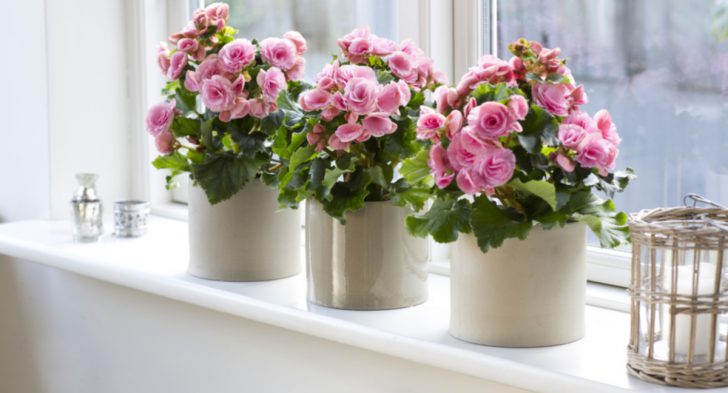
For begonias, a room with good lighting is suitable.
A container with begonia is best placed on the windowsill of a window facing west or east.In the cold season, when daylight hours are shortened, it is advisable to organize perennial illumination.
This plant loves moisture, so it needs frequent watering. You can use only soft, pre-settled water.
Excess accumulated in the pan is drained in a timely manner.
Watering rules:
- in autumn, from October, the flower is watered when the topsoil begins to dry out;
- in winter it is reduced to a minimum;
- with the advent of the first spring month, they begin to moisten the soil more abundantly;
- in summer, the soil is moistened 2 times a week, in the heat - daily.
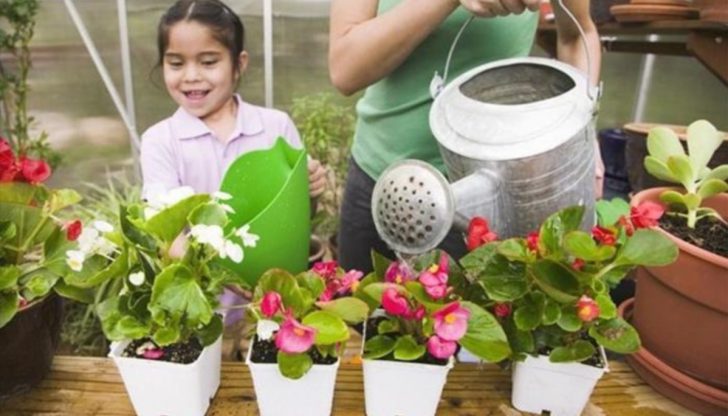
Begonia needs frequent watering
Tuberous varieties of this perennial hibernate during the cold season. At this time they are placed in peat, do not water.
Air humidity
Due to its tropical origin, the plant requires high humidity. Using the usual method for her - spraying from a spray bottle - is prohibited, this can lead to various diseases, the formation of spots on its leaves.
Experienced flower growers organize the optimal microclimate for a perennial by placing a pot on a saucer with wet peat poured into it. Another equally effective way is to pour pebbles into the container, fill the bottom with water and put the pot on the pebbles. The liquid evaporating in this case will create the necessary conditions.
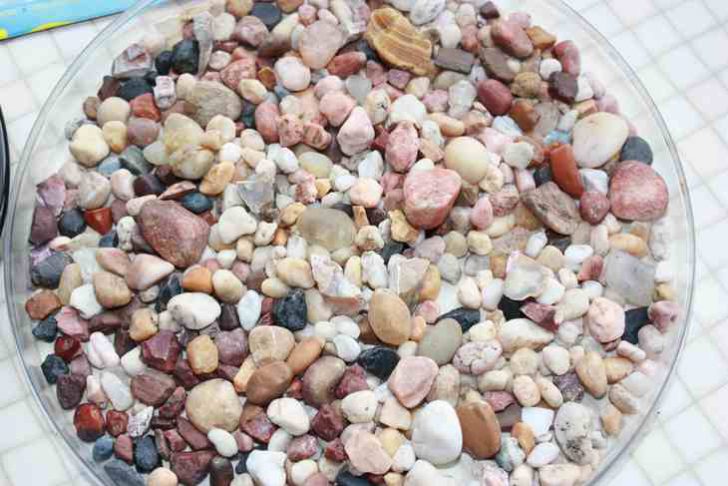
Pour the pebbles into the begonia watering container
Recommended air temperature
Begonia does not withstand sudden changes in temperature, but feels good in moderate. In summer, it is best to keep the pot in a room with a temperature of 18 - 20 ° C, in winter you need to make sure that the room is at least 15 ° C.
Soil and fertilizer
The plant develops well only in nutrient soil. To do this, take 1 part of black soil and peat with two parts of leafy humus.
The bottom of the pot is covered with river coarse sand, then half filled with leafy humus. Chernozem mixed with peat is poured into the remaining space.
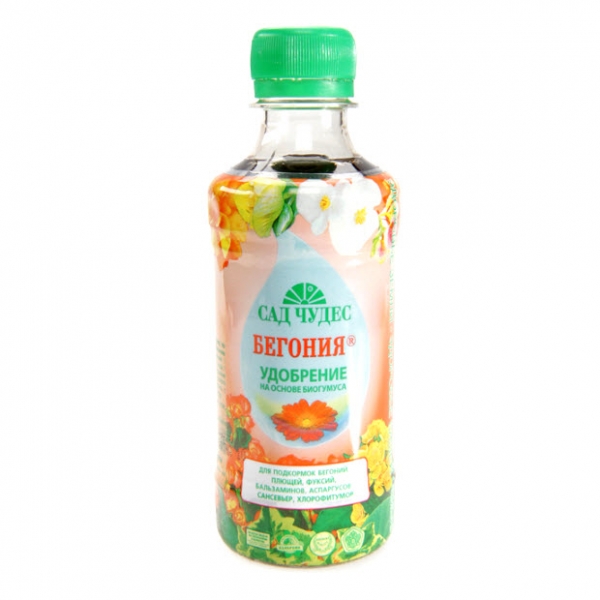
Begonias need to be fed regularly.
In order for the plant to bloom and be beautiful, it is necessary to feed it. Do this 1 - 2 times a month, from the moment the buds form until the end of flowering (spring - summer). You can feed begonias with mineral fertilizers.
Transplant rules
It is recommended to transplant the plant every 2-3 years, in the spring. To understand whether you need to transplant begonias, you should examine the soil. If roots are visible from it that no longer fit in a pot, it's time to transplant.
The new container for the flower should be about 3 cm larger than the diameter of the old pot.
The plant is carefully taken out, the roots are thoroughly cleaned from the soil.
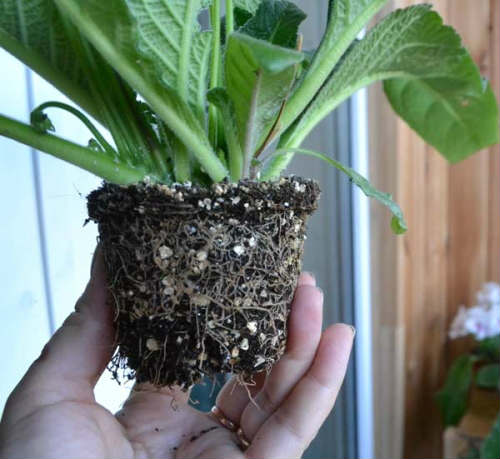
Carefully remove the plant from the pot
Dilute a weak solution of manganese, put a flower in it. An hour later, they take it out, carefully examine the roots - they should not have damage or rotting areas. If there are any, they are removed.
The prepared pot of larger diameter is filled with a layer of expanded clay, coarse-grained sand is poured on top. They put the plant in a container, then fill the free space with soil, acting carefully so as not to damage the root system. Then water abundantly, do it regularly after transplantation.
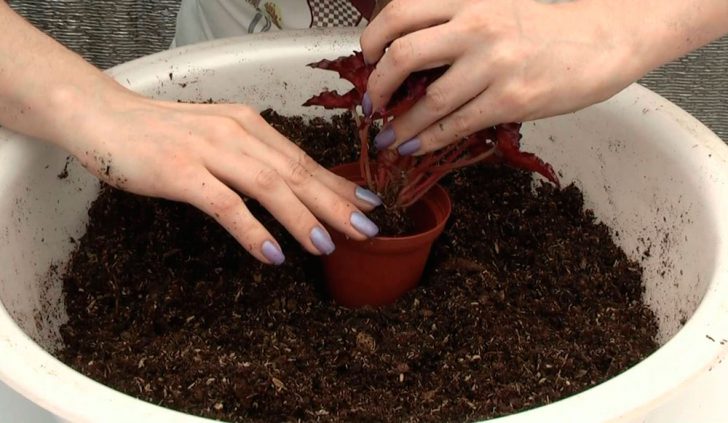
Transplant into a larger pot
Reproduction of begonia
Planting a perennial can be done using seeds or tubers; for reproduction, the method of dividing the bush, cuttings of stems or leaves is used.
cuttings
The procedure is carried out in spring and summer. A suitable stem is chosen - its minimum height should be 7 cm. Once the stem is cut, it is placed in a wet mixture consisting of three parts of peat and one part of sand. The container with the substrate is placed in a dark place. The rooting process takes about 1 - 2 months.
To propagate a plant with a leaf, you need to take the largest and strongest.It is placed in the soil so that it stands vertically, not in contact with the earth layer. Placed in a dark place, kept there until rooting.
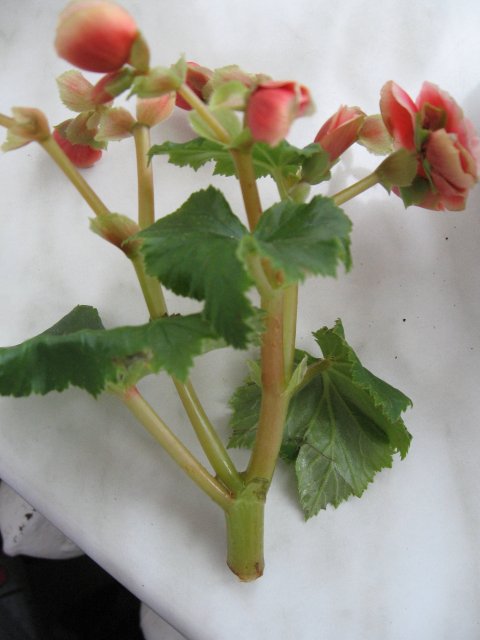
begonia stalk
Growing a plant from seed
The method of propagation of begonias from seeds can be used from the beginning of winter to the beginning of spring.
First, a nutrient substrate is prepared: a layer of sand, leafy humus and peat. Seeds are sown, gently and shallowly pressed into the top layer of soil. The first shoots appear after about 2 weeks.

Begonia shoots
Then the seedlings dive. The grown plants are transplanted into separate pots. In July, the young begonia begins to bloom. In autumn, the plant is placed in peat, placed in a room where the temperature is kept at 10 ° C. Closer to winter, the formation of a tuber ends. In the spring, the begonia is again transplanted into a pot.
back to index ↑Rules for caring for plant tubers
Planting a tuberous plant begins from February to June. The flowering time of the perennial also depends on the period in which the planting was made.
Basic landing rules:
- tubers should be only half in the soil;
a container with soil is placed in a dark place in which a cool temperature is maintained - watering is moderate, for several weeks
- after the shoots appear, the part of the tuber sticking out of the soil is covered, the container with the plant is placed on a windowsill or other warm, well-lit place.

begonia tubers
Garden begonia - rules for planting and caring for perennials
A garden perennial plant differs from an indoor plant in greater endurance: it perfectly tolerates any weather conditions, grows in flower beds and gardens.
The color of the garden begonia petals is diverse: from pale white to rich purple. You can get acquainted with all varieties of garden begonia by studying the catalogs of nurseries or flower growers.
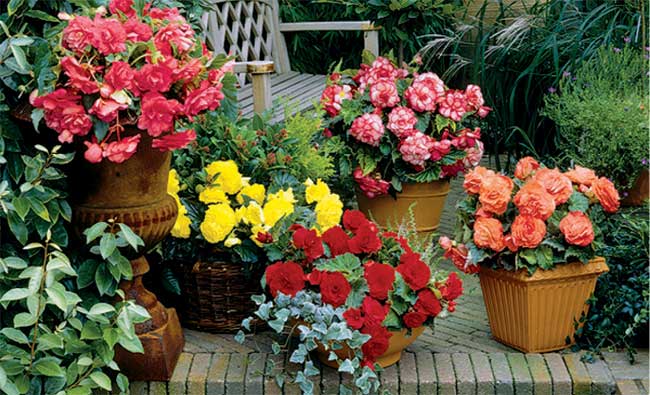
garden begonia
The maximum height of a plant growing in open ground is 25 cm.
To grow this beautiful perennial, you should learn the rules for planting and caring for it.
Planting garden begonias
The plant belongs to the photophilous, but it is impossible to plant it in places where direct sunlight falls. Under their influence, the perennial will develop more slowly, bloom poorly. It is best to place it in those areas of the garden that are covered with tall trees.

Avoid planting begonias in direct sunlight
Having chosen a suitable place, you need to wait for June - landing can be carried out no earlier than this month. In June, the most favorable conditions for the plant are created: warm weather without sudden changes in temperature, an abundance of sunlight. If you try to plant a begonia earlier, it will most likely die, because it does not tolerate even small frosts.
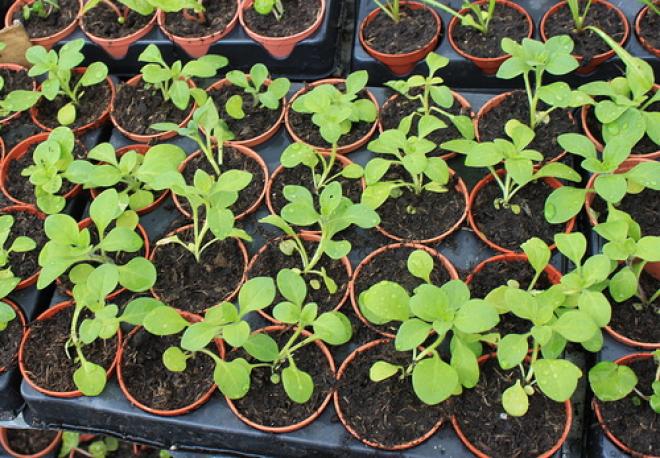
You can buy ready-made begonia seedlings
For planting plants, seedlings are used, which can be purchased at a nursery or grown independently using seeds.
Features of care
Begonia loves water and grows best in well-drained soil.
A small amount of compost or peat is added to the hole in the open ground; mineral fertilizers, which contain phosphorus and potassium, can also be used.
When the plant is planted, the soil should be moistened so that the seedlings take root faster.

Planting begonias in open ground
Periodically, you should carefully loosen the soil around the perennial so that the root system receives oxygen.
Begonia loves water and grows best in well-drained soil. Immediately after planting, the seedlings are watered at least once every 3 days, and if the weather is hot and there is no rain, then they begin to water more often, not forgetting to loosen the ground after that.
It is important to ensure that water does not stagnate in the soil - this can lead to rotting of the roots.To prevent this from happening, even at the landing stage, the bottom of the hole is covered with drainage material (gravel, expanded clay, coarse sand, and others).

Begonia loves well-drained soil.
It is impossible to spray the plant with water - the moisture accumulated on the leaves can cause brown spots to appear on them. In the fall, to prepare the perennial for wintering, they stop watering the begonia.
Winter plant care
With the advent of cold weather, at the very beginning of October, the stems of the plant are cut off, leaving a part protruding from the tubers by about 3 cm. Then they dig up the tubers themselves, bring them to the living quarters and leave them there to dry for 2 weeks.
After this period, the tubers are carefully but thoroughly cleaned of clods of earth and dried stems, placed in a box where they will be stored until spring. Fall asleep with sand. The box is placed in a cool place.

For the winter, begonia tubers are dug up
If you only need to save a few tubers, you can put them in the refrigerator.
reproduction
Garden begonia is a tuberous plant. In order to plant a large flower bed with this plant, you can purchase several tubers, and then propagate it.
When buying, you need to pay attention to the age of the planting material - it is best to choose young ones. Their diameter should not be more than 6 cm. Even shriveled tubers are viable if they have live eyes.
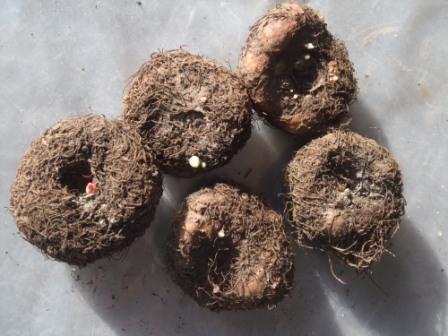
The diameter of the begonia tuber should be no more than 6 cm.
In winter, they are placed in a cool place in a container with wet sand. It is important to monitor the level of humidity - it is impossible to allow the sand to dry completely, however, an excessively large amount of water can harm: the tubers will begin to rot.
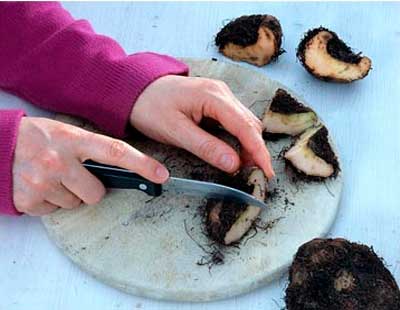
Division of a begonia tuber
You can start planting them in a nursery already at the very beginning of spring, so in May buds will already bloom on them.
Before starting planting, each tuber is carefully inspected, the old roots are removed.
To disinfect them, the prepared parts are placed for 30 minutes in a weak solution of manganese or 1% hydrogen peroxide solution. Using this technique, you can also get rid of traces of mold on planting material, but first you need to carefully, trying not to damage the sprouts, remove all mold.
You don’t have to use folk remedies - in the department for gardeners, special products are sold for treating perennial tubers, after which the plant will not only be disinfected, hardened and will be able to resist most diseases, but will also receive top dressing.
tubers
Plants begin to germinate tubers at the end of winter. It also helps to increase the amount of planting material for the garden.
Procedure:
- A small box is filled with wet sand, then tubers are planted in it.
- After the appearance of the first sprouts, the tuber is cut. Each part must have at least 1 shoot.
- The cut sites are treated with crushed coal, then left for several hours to dry.
- After the specified time, the seedlings are planted in pots.

Germination of begonia tubers
Plants need the same care that is required when growing seedlings.
Perennial tubers increase annually as they accumulate a lot of nutrients. At the same time, begonia flowers also increase.
Garden begonia can be planted not only in flower beds - it is also used for landscaping balconies, window sills, open terraces. If you grow an outdoor perennial in a pot, it will bloom just as luxuriantly.

Begonia can decorate window sills at home
cuttings
Adult garden begonia can be propagated by other methods:
- The sprout that appeared on the germinated tuber is carefully removed, planted in a glass filled with a nutrient mixture. It should rise only a couple of millimeters above the soil surface. With this method, the sprout will take root quite quickly, and up to 6 individual plants can be obtained from one tuber.
- The upper part of the shoot, on which there are 6 leaves, is cut off from the perennial, all buds and flowers are removed. The cut point is smeared with a rooting agent, which can be purchased at the store. You can also use homemade, which is suitable not only for begonias, but also for all flowers (both indoor and garden). To prepare it, dissolve a teaspoon of aloe juice and honey in half a glass of water. You can store the finished product for no longer than 48 hours. The treated cutting is placed in moist soil, a plastic bag is pulled over the pot or covered with a film. Rooting occurs over the next week, after which the package is removed.
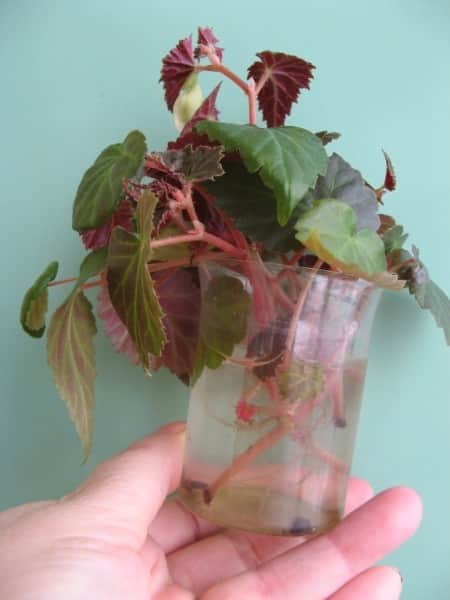
Sprouting begonia cuttings
If there is high humidity in the room where the pot is standing, it is necessary to ventilate it regularly. Otherwise, the perennial can become sick with powdery mildew. Signs of this disease are voluminous fluffy spots of white color. If such symptoms are detected, the diseased sprouts are destroyed by burning them, and the remaining healthy plants are treated using a manganese solution.
Planting begonias in a flower bed can be carried out 2 months after growing on a windowsill. Patterns made up of flowers of the same type look spectacular and beautiful.
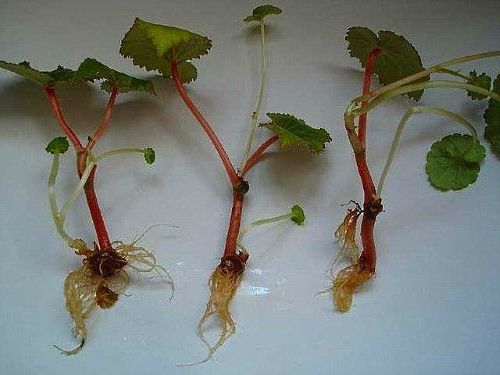
After 2 months, cuttings can be planted in the ground
Plants should be planted at a distance from each other not exceeding 20 cm - in this case, perennial bushes will quickly cover the entire flower bed with a solid carpet. After all the seedlings are planted, the ground is mulched so that the soil does not dry out.
For this purpose, you can use sawdust, expanded clay, peat - in this case, you do not have to loosen the ground, and you can water it less often.
In summer, the plant needs to be fed with universal formulations for flowering plants. It needs to be done twice a month.
Conclusion
Garden begonia is an unpretentious, disease-resistant perennial that is great for both outdoor and indoor growing. She almost does not need care, but generously pleases with lush flowering.
Photo gallery - begonia
Video
